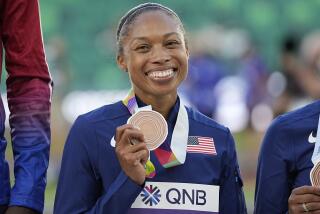Former Model Likes to Walk to a Racing Pace
NEW YORK — In 10 years, Viisha Sedlak, a former Wilhemina model, has gone from being unable to run a quarter-mile to an ultra-distance runner to a world-class racewalker.
Now she’s campaigning to make her sport more widely known and, hopefully, get it recognized as an Olympic event.
Sedlak, a 6-foot, 127 pounds natural athlete, did not begin her running career until 1979, when she was living in Honolulu.
“I was getting cellulite and mushy,” she said. “I had quit modeling and had just opened a business. I had not exercised for years and I was getting out of shape.
“One day, in Stockholm, I looked in the mirror, and said, ‘This is not what I want to look like,’ even though I was still thin.
“When I started, I couldn’t run 400 meters,” Sedlak said. “I had to stop after 100 meters or 200 meters. For a week, every time I tried to jog, my pulse went up and my muscles started to burn. I could only go about 40 feet.
“A few weeks later, I could run a mile. A few weeks after that, I could run two miles, and later that year, I ran in the Honolulu Marathon. I ran the first 20 miles in three hours, but it took me 1 hour, 27 minutes, to run the last six miles. I fell apart.”
In 1983, she ran more than 800 miles, from Denver to Dallas, in 32 days. And last year, she ran almost 400 miles in six days.
“I was astounded at what my physical and mental capabilities were,” she said.
Sedlak no longer does ultra-distance events, instead concentrating on her racewalking endeavors.
“I miss the strength they gave me,” she said. “I gave them up because of racewalking. The training is not complementary. I lose a lot of leg speed.”
Sedlak needs the leg speed for the shorter walking events in which she competes. This year, she earned a spot on the U.S. racewalking team by placing eighth in the 10-kilometer (6.2-mile) national championships.
That is the distance at which she hopes to compete during the 1992 Barcelona Olympics--if the event is approved for the Games. As yet, there are no racewalking events for women in the Olympics.
Now 39, Sedlak teaches racewalking in private classes at Boulder, Colo., gives self-improvement clinics to corporate walkers, and as a representative of the U.S. Shoe Corporation, she conducts racewalking clinics throughout the country.
Meanwhile, Sedlak has become an outspoken ambassador for the sport, and for women, in particular. She has made her points by her actions--including setting age-group records nearly every time she competes--and by her words--speaking often to various groups about the benefits of walking, not necessarily in competition, but just for exercise.
“Walking is an activity people do every day,” she said. “They walk to the store, they walk with their husbands, they walk the dog. Walking is one of the safest sports, along with swimming.
“Now, a lot of people want to learn to racewalk. Racewalking looks funny, but that’s to someone who doesn’t know the technique. When you’ve developed the technique, it’s fluid and smooth, and it’s nice to watch.
“And it’s easy to learn.
“I can teach anyone to walk in a one-hour session,” Sedlak said. “To feel comfortable, to be able to do it efficiently, of course, takes longer . . . several years.
“I’m fairly new at the sport myself. I’ve only been doing it for two years.”
In that short time, however, she has become very proficient at it.
“When I was younger, I loved sports, but I never thought of myself as a runner or an athlete,” Sedlak said. “I was even told by my high school gym teacher in San Diego that I couldn’t run . . . that I had no ability.
“But now, when I go out and train, it feels exactly what I should be doing . . . what I was designed to do . . . what I was meant to do.
“People tease me about that, but I’m so happy in what I’m doing, it doesn’t bother me. I love to win and I intend to win when I compete. But some of my favorites races are not the ones I have won.
“I just enjoy competing. When people say competition isn’t healthy, I just get on my bandwagon. It’s not necessarily competition against others, but competition against yourself.”
Sedlak not only enjoys motivating herself, but also others.
“I teach people how to make the best of themselves,” she said. “And that’s very satisfying.”
More to Read
Go beyond the scoreboard
Get the latest on L.A.'s teams in the daily Sports Report newsletter.
You may occasionally receive promotional content from the Los Angeles Times.






